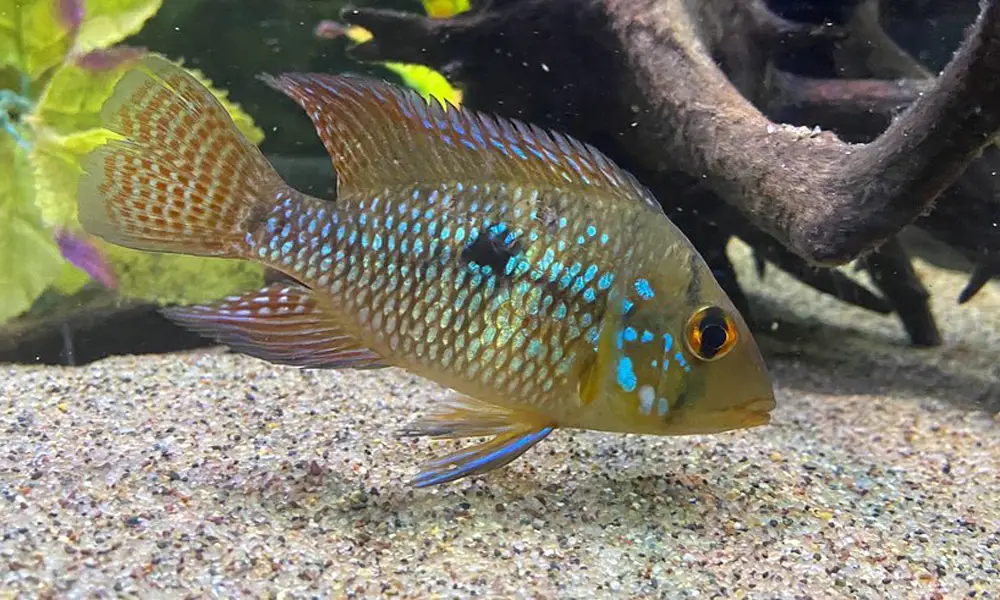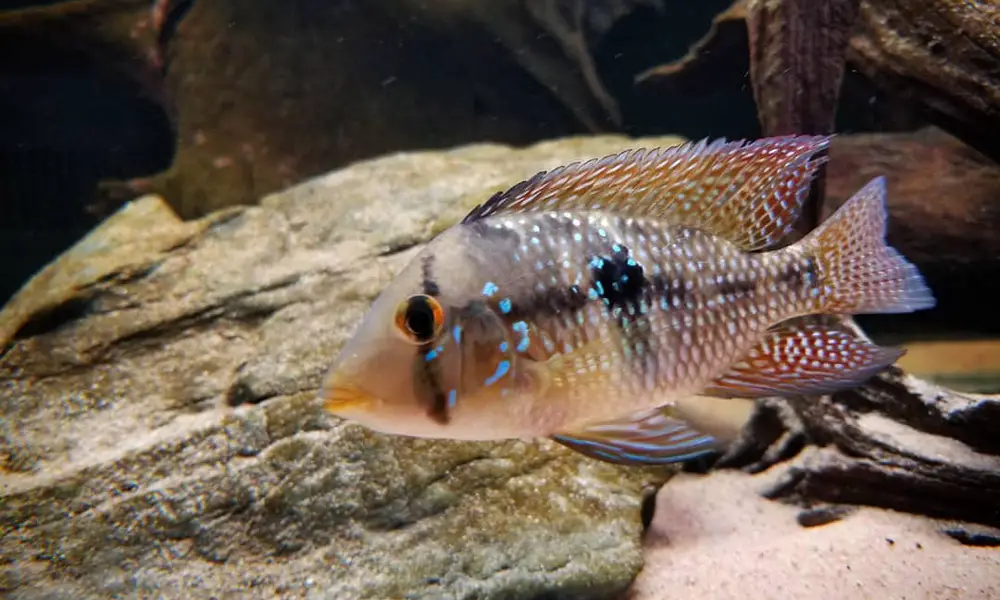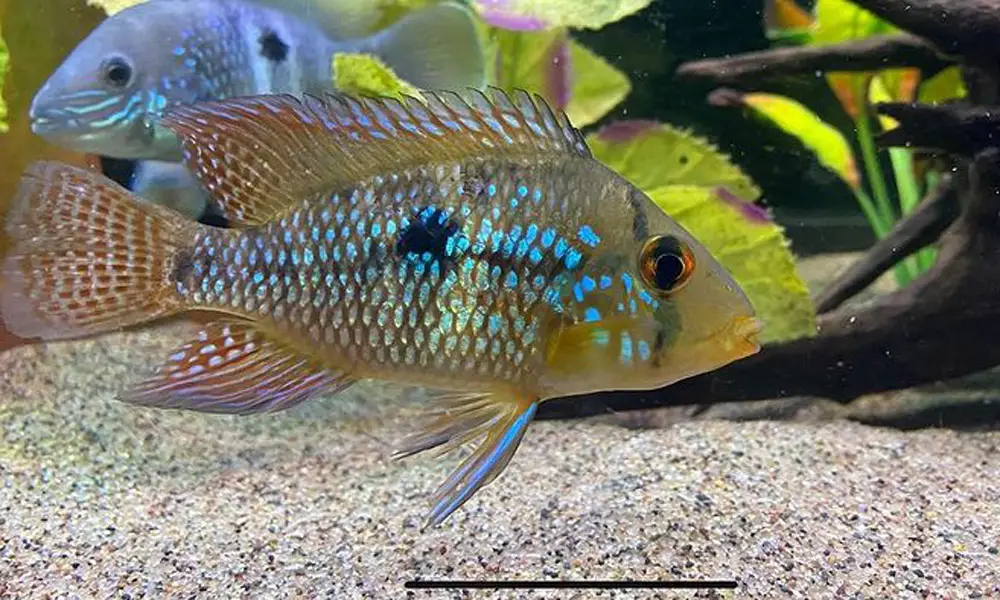Geophagus Brasiliensis is one of the earliest imported cichlids in the aquarium trade. It is a durable fish and easy to breed in captivity, making the cichlid a superior choice for both the beginner and experienced cichlid keeper. Moreover, this fish is widely known for its ability to change its coloration during spawning.
Although it belongs to the Geophagus genus, it doesn’t have much in common with the other eartheaters. Want to know more about these pretty cichlids and thinking how to care for them?
Here’s a comprehensive guide that will walk you through the pearl cichlid care fundamentals so you can keep them in your aquarium without any hassle.
Species Summary
Geophagus Brasiliensis is commonly known as pearl cichlid, pearl eartheater, Brazilian Eartheater, and Mother of Pearl Eartheater. It was first described in 1824 by Gaimard and Quoy.
G. Brasiliensis belong to the Geophagus genus but shares no similarity with the other eartheaters. This genus currently has 31 recognized species, and many species are still undescribed.
Geophagus means earth-eater, which is derived from the Greek word “geo” meaning earth, and “phagein” meaning to eat. Eartheaters are known for their peculiar feeding habits where they constantly sift through the substrate in search of food, using their down-turned mouths. But, G. Brasiliensi is an exception because of its straight mouth.
G. Brasiliensis mainly originates from eastern and southern Brazil, Paraguay, Uruguay, and far northeastern Argentina, where it is found in a wide variety of harder and more alkaline habitats, such as the lower reaches of coastal rivers, lakes, and slightly salty lagoons. Compared with its restricted distribution, other Geophagus species are widely found in the Amazon basin.
Plus, unlike many other eartheaters, G. Brasiliensis is not a mouthbrooder.
Having said all of the above, G. Brasiliensis may eventually be removed from the genus Geophagus.
Being one of the most popular South American cichlids in the hobby, Today, G. Brasiliensis has been introduced into Australia, Florida, the Philippines, and Taiwan thanks to the aquarium trade.
| Scientific Name: | Geophagus Brasiliensis |
| Common Name: | Pearl Cichlid, pearl eartheater, Brazilian Eartheater, and Mother of Pearl Eartheater |
| Origin: | South American |
| Care Level: | Easy |
| Size: | 11.0 inches (27.94 cm) |
| pH: | 6.2-7.5 |
| Temperature: | 68.0 to 73.0° F (20.0 to 22.8° C) |
| KH: | 10 – 15 dGH |
| Minimum tank size: | 75 gallons |
| Diet: | Omnivorous |
Appearance

Pearl cichlid is one of the most stunning species to add to your aquarium. It is a high bodies fish, identical to Texas or Convict cichlid, but with a slightly more pointed mouth. These species are popular for their color-changing ability during spawning.
They mainly feature gray-gree color with a covering of bluish-white flecks. Also, their fins look incredible with red coloring, and the center of their body reflects a dark round spot, making them look stand out.
However, the fish changes its color from pale brown to dark blue, even purple during spawning. Like other cichlids, these also have spiny rays in the back parts of the dorsal, pelvic, anal, and pectoral fins.
As we mentioned earlier, you can plainly see the difference between Pearl cichlid and most Eartheaters from its straight and more pointed mouth in the front of the face.
Both males and females have similar coloration. The most dominant males feature a nuchal hump on their head portion, which grows larger with their age. But some males don’t show the hump. The males may also have a longer dorsal fin.
A 100% accurate method of identifying whether you have a male or female is venting them. The male Pearl cichlid has more prominent genital papillae while the female is blunt and more frequently rounded.
Geophagus Brasiliensis (Pearl Cichlid) Size
Pearl Cichlid is a large South American cichlid with a maximum size of 11 inches in length. Females grow smaller than males and reach up to one-third or half the size of males.
When they are sold in the aquarium trade, they are usually 2 to 3.5 inches in length. These fish grow relatively faster than other Geophagus groups, like G. Altifrons and G. sveni. With frequent water changes (30 – 40% every other day or 75% biweekly) and an adequate diet, a male Pearl Cichlid can reach its full size in a year or even earlier from 2 inches.
Owing to their large size, they require a spacious aquarium where they can grow easily. They develop pearly dots on their body when they reach up to 3 – 4” in length.
Lifespan
The average lifespan of Pearl Cichlid is about 10 to 15 years with proper care. However, their long life expectancy doesn’t mean that you can skip over the care part. Provide them with a good diet and appropriate tank conditions to save from any health concerns later.
Geophagus Brasiliensis (Pearl Cichlid) Care

You’ll be glad to know that Geophagus Brasiliensis is an excellent choice for any level of fish keeper, including a novice. They are hardy species that readily accept a wide variety of food and tolerate various water conditions. Moreover, these species can endure sudden and drastic water changes without causing any trouble.
But while they are easy to care for, there’re certain conditions you should fulfill to let them thrive in your home aquarium. Below are mentioned certain guidelines to follow.
Tank Size
A minimum of at least a 40-gallon breeder (36″ x 18″ x 16″) aquarium is required to keep a single pearl cichlid. For a bonded pair, you need to increase the aquarium to 75-gallons (48″ x 18″ x 21″) or more.
To avoid conspecific aggression issues, we highly recommend an optimal 125-gallon (72″ x 18″ x 21″) fish tank for long-term care.
In addition, moderate water movement and efficient filtration is also required to keep these cichlids happy and healthy.
Water Parameters
Maintaining the correct water parameters is mandatory to make these cichlids feel comfy in their new home. Conduct frequent partial water changes and keep nitrate to a minimum. Although these species can endure a sudden change in water chemistry for a while, they are susceptible to deteriorating water conditions.
In their natural inhabits, Pearl cichlids are found in harder and alkaline waters; they can be kept in slightly brackish water but will not survive in a full brackish water environment.
Follow the below-mentioned water parameters to avoid any trouble later on.
- pH: 6.0 – 7.2
- Water Temperature: 68 to 79 F
- Hardness: up to 15 degrees
- Ammonia: 0 ppm
- Nitrite: 0 ppm
- Nitrate: <30 ppm
Decor (Plants and Substrate)
Unlike many other Geophagus species, a soft sandy substrate is perfect but not essential for G. Brasiliensis because this fish doesn’t sift through the substrate aggressively.
Add some rocks and roots to offer them ample hideouts and caves.
You can also add tangles of driftwood to help them build and separate their territories. They are likely to consume plants, so it’s best to pot the plants and the soil surface with rocks.
Food
- New Life Spectrum is made from quality natural ingredients
- Extreme Color enhancement and vitality in your fish
- Made in the USA
Geophagus Brasiliensis is not picky; feeding them is pretty simple.
In the wild, they feed on insects, algae, and detritus found on the substrate. Sometimes, they sift the substrate a little bit for edible items.
They are omnivores that will readily accept most foods. You can give them a quality flake food or pellet diet as the base and supplement it with live foods such as earthworms, brine shrimp, crickets, and daphnia. Geophagus will also accept vegetables such as cucumber, zucchini, and peas.
So feel free to get creative with their diet; just make sure do not overfeed them and prefer giving food in smaller quantities rather than a large meal portion.
Geophagus Brasiliensis (Pearl Cichlid) Tank Mates
Pearl cichlids are mildly aggressive species that are best maintained single or a compatible pair. However, you can place them within a community tank with other species, but make sure to choose the right tank mates to avoid any trouble.
Since they are large-sized fish, avoid keeping them with small ones. Their ideal tankmates can be other South American cichlids of identical temperament and size, Loricariids, Brochis catfish, and characins. Also, keep them with those species who enjoy similar water conditions.
These species become very territorial at the time of spawning and show much aggressive behavior towards other males.
Some suitable tank mates for the Pearl cichlid:
- Sajica cichlid (Amatitlania sajica)
- Red Shoulder Severum or Rotkeil Severum (Heros sp. Rotkeil)
- Chocolate Cichlid (Hypselecara temporalis)
- Red Tiger Severum (Heros Severus)
- Threadfin Acara Cichlid (Acarichthys heckelii)
- Jack Dempsey Cichlid (Rocio octofasciata)
- Green Terror (Andinoacara rivulatus) [Female | Size | Tank Mates]
- Pterygoplichthys gibbiceps (Leopard pleco)
- True Parrot Cichlid (Hoplarchus Psittacus)
Breeding
Their ability to breed in captivity makes them worth adding to your collection. G. Brasiliensis is a bi-parental substrate spawner, which can be easily bred in home aquariums.
It’s recommended to start with a group of juveniles, and they will naturally pair off when they reach 2 – 3″.
When they are ready to spawn (About 4″), the pair will clean a spawning site. A female will lay 150-200 eggs on a smooth stone or flat piece of driftwood in a darker place. The parents will then look after and protect the fry until they are free-swimming.
To induce spawning, you need to maintain the correct water parameters and provide them with an ample diet. Also, you can use live foods to trigger their breeding instinct.
It’s best to create a separate breeding tank with the following water conditions.
- pH: 6.5 – 7.0
- Water Temperature: 75 – 81° F (24 – 27° C)
- Hardness: 5 – 10° dH
Final Thoughts
That’s all, friends!! We hope you have now learned about everything about Geophagus Brasiliensis care fundamentals. These species are suitable for all kinds of aquarists, whether you are a beginner or an expert. They are peaceful, hardy, and relatively easy to look after.
Provided you maintain the correct water parameters and offer them a well-balanced diet, Geophagus Brasiliensis will certainly reward you with years of enjoyment.
So what are you waiting for? Go ahead and add these beautiful creatures to your freshwater aquarium. These fish will surely brighten up your home space with their pleasant personality and active behavior.
As always, if we miss anything or you have any queries regarding Geophagus Brasiliensis care, please don’t hesitate to drop a comment below. We would love to hear from you!
Happy Fish Keeping!! 🙂






